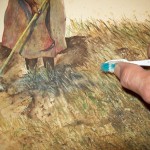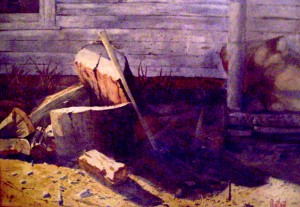
“Let your darks be dark and your lights light“~Howard Pyle
Tip: Do not consider all accidents in your painting a “ruin” of the painting. Many accidents can be turned into “happy” accidents. Artists are creative by their very nature. Use your creative imagination when an accident occurs and see if you can use it to advantage. Accidents in the form of strokes, glazes and washes may be used and (in many cases) should be retained.
Tip: If areas of your painting seem flat or bare, use a dry brush technique to liven it up. For example, if you have a highway or road, a brick wall, that seems flat and uninteresting (unless it is planned), you may want to dry brush “cracks and holes” into the area. This is especially true if you do not over do it. Keep it simple but not dull.
Tip: Be aware of the values. Too much mid-tone will leave your painting feeling flat, while too much light colors in the painting will leave it lacking spirit and vitality. The painting will lose its luminosity if has too much dark value. The good news is most all of these “happenings” can be corrected with lifting, glazing, dry brushing, splattering, cropping, and etc.
Tip: When correcting mistakes, constantly keep in mind the danger of “over-working” the watercolor and making it muddy. The above tip suggests ways of livening up your painting, but if it is over worked, it may be ruined.

As an artist and writer, I could probably write an entire book about ways to save and liven up a watercolor; however, sometimes the painting works best if proper planning is done before the paint hits the paper.
Tip: Every painting is your own individual expression. It represents how you think. Before beginning, do your mental exercises considering the (1) focal point, (2) tone, (3) color, and (4) balance.
